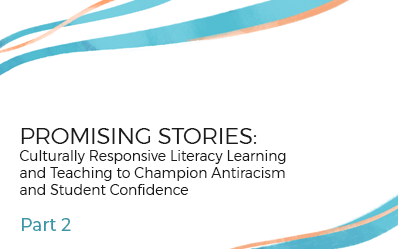Promising Stories, Part 2: It Starts With Stories…Your Stories, My Stories, Our Stories
This is the second in a multi-part series by Laura Benson, ISS Director of Curriculum and Professional Development. Find other installments here: Part 1, Part 3, Part 4, Part 5, Part 6.
Promising Stories: Culturally Responsive Literacy Learning and Teaching to Champion Antiracism and Student Confidence
Human conversation is the most ancient and easiest way to cultivate the conditions for change – personal, community, and organizational change.
Wheatley, 2002
It Starts With Stories…Your Stories, My Stories, Our Stories
To build learning on the oral traditions of students’ cultures, infuse opportunities for students to talk with one another and create stories – fiction, nonfiction, and poetic stories and stories told via oral, written, and artistic vehicles – daily. Encouraging talk and storytelling rituals give students opportunities to compose their thinking and deepen their understanding. The language we use and nurture in our classrooms helps us prime, prompt, and pattern our students’ thinking (Ritchhart, 2002).
Culturally Responsive Learning Strategies:
TURN & TALK/THINK-PAIR-SHARE
When teaching, talking to, or reading to students, utilize talk to help students prime, process, and retain (Jensen) their understanding. I often utilize the “5 minute rule.” For every five minutes of listening, I stop and give students opportunities to talk to one another (or draw, take notes, act out their thinking, etc.). As Australian educators Carole Cooper and Julie Boyd say, we often don’t know we know something until we hear ourselves say it in an interaction with another person.
READ-TALK-WRITE
- Teacher selects a short and spirited text for students’ reading. Teach identifies stops signs by chunking text for students’ reading and conversation.
- Students read a portion/section of a text independently or collaboratively. They are cued to read a chunk of text with teacher’s stop sign (oral or written cue).
- At the stop sign, students talk to a partner about the text sharing their thinking.
- Students repeat Steps 2 and 3 until they complete the reading the text.
- Students write about the text (Student writing might be anything from a one sentence summary to a poem or a reflective paragraph depending on the teachers’ intentions and goals for using this activity and text.).
Option: Between Steps 2 and 3, ask students to draw their thinking about the text. Students can then utilize their drawing to consider what they will talk about and/or share their drawings during their partner discussions. Also, students can engage in Step 3, the talking, with a small group of peers (if there is ample time for all the members to voice their thoughts).
PARAPHRASE PASSPORT
- Pair students up and have them face one another chair to chair.
- Each pair decides who is Partner A and who is Partner B.
- Partner A reads paragraph 1 aloud.
- After Partner A reads, Partner B paraphrases the passage.
- Then, Partner B reads paragraph 2 aloud.
- After Partner B reads, Partner A paraphrases the second paragraph.
- Process is repeated until the text is completed.
- Partners discuss text and take notes (if appropriate/helpful) and record their thoughts in a passport style journal.
Optional: Teacher and/or students can generate a question(s) to guide partners’ reflective and deepening discussions.
CHOICE
Model and encourage students to generate their own topics for writing poetry, nonfiction, and fiction. Texts and content area writing, too. A good rule of thumb, one I learned from Don Graves and one which I continually witness as a transformative energizer in students’ writing, is the 80/20 rule. 80% of the time students should be generating their own writing topics and 20% of the time we can offer students assignments, prompts, or guided topics. This message is echoed by Ralph Fletcher in Boy Writers as a compelling way to engage boys in literacy.
Also, choice can and should be a part of students’ reading regimens. I do guide students to good fit texts (books and reading texts which reflect and strengthen each child’s current independent reading level as well as texts which nurture a child’s zone of proximal development for guided practice, too). But I don’t put students on an exclusive leveled texts diet at all. Students need to have daily opportunities to read whatever they want to read.
Instructional conversation, the kind of talk that acts like a mental blender, mixing together new material with existing knowledge in a student’s schema. Using discussion protocols like World Café, Four on a Pencil, and Give One Get One help create variety in the ways students talk to each other in the classroom, offering a chance to both work collaboratively and have their individual voices heard.
Zaretta L. Hammond, Culturally Responsive Teaching and The Brain
All installments of the Promising Stories series can be found here:
- Part 1: Introduction
- Part 2: It Starts With Stories…Your Stories, My Stories, Our Stories
- Part 3: Culture Connections, and Build on Students’ Strengths
- Part 4: Reflection, and Outside Learning as an Avenue for Inside Learning
- Part 5: Books are Mirrors and Windows
- Part 6: It’s All About Relationships
View References and Resources for Developing Culturally Responsive Learning and Nurturing Antiracism
You can also follow Laura at @lbopenbook, plus view her curated antiracism padlet here.







